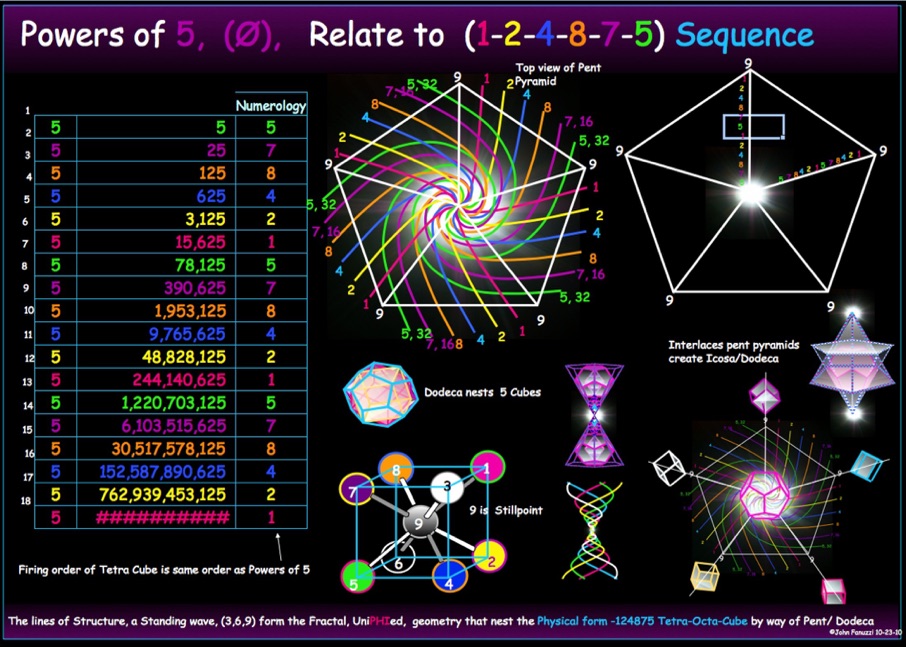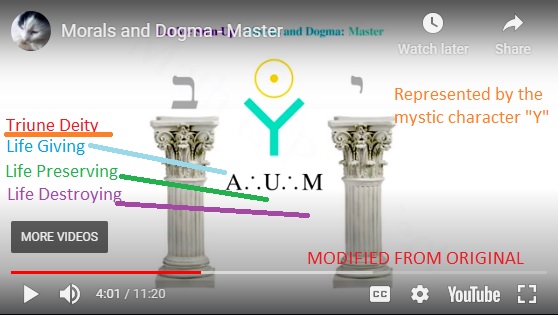The following fascinating graphics come from the website InternalStargate.com.

I knew I had seen the number 117 on several occasions. I remembered it because I was trying to find the connection between the Hebrew letter QOF that has a value of 100 with the letter Q, the 17th letter of the English alphabet.

In this case, 117 is obtained by adding 52 and 65 in the left and right columns. Those are the sums of all 12 numbers in each column. The numbers in each column are obtained by starting with the Fibonacci sequence in the upper left and moving downward. When a double digit number is reached, you reduce to a single digit by adding each number in the double digit together. This produces a series of 24 numbers that repeats infinitely.









Om or About this sound aum (help·info) (written universally as ॐ; in Devanagari as ओं oṃ [õː], औं auṃ [ə̃ũ], or ओम् om [õːm]) is a mystical Sanskrit sound of Hindu origin, sacred and important in various Dharmic religions such as Hinduism, Buddhism and Jainism. The syllable is also referred to as omkara (ओंकार oṃkāra) or aumkara (औंकार auṃkāra), literally "om syllable", and in Sanskrit it is sometimes referred to as प्रणव (praṇava), literally "that which is sounded out loudly".
Om is also written ओ३म् (ō̄m [õːːm]), where ३ is प्लुत (pluta, "three times as long"), indicating a length of three morae (that is, the time it takes to say three syllables)—an overlong nasalized close-mid back rounded vowel—though there are other enunciations adhered to in received traditions.

(This is the symbol found in the Crown Chakra).
The syllable "om" is first described as all-encompassing mystical entity in the Upanishads. Today, in all Hindu art and all over India and Nepal, 'om' can be seen virtually everywhere, a common sign for Hinduism and its philosophy and theology. Hindus believe that as creation began, the divine, all-encompassing consciousness took the form of the first and original vibration manifesting as sound "OM".[3] Before creation began it was "Shunyākāsha", the emptiness or the void. Shunyākāsha, meaning literally "no sky", is more than nothingness, because everything then existed in a latent state of potentiality. The vibration of "OM" symbolizes the manifestation of God in form ("sāguna brahman"). "OM" is the reflection of the absolute reality, it is said to be "Adi Anadi", without beginning or the end and embracing all that exists.[3] The mantra "OM" is the name of God, the vibration of the Supreme. When taken letter by letter, A-U-M represents the divine energy (Shakti) united in its three elementary aspects: Bhrahma Shakti (creation), Vishnu Shakti (preservation) and Shiva Shakti (liberation, and/or destruction).[3]
The syllable is mentioned in all the Upanishads, specially elaborated upon in the Taittiriya, Chāndogya and Māndukya Upanishad set forth as the object of profound religious meditation, the highest spiritual efficacy being attributed not only to the whole word but also to the three sounds a (a-kāra), u (u-kāra), m (ma-kāra), of which it consists. A-kara means form or shape like earth, trees, or any other object. U-kāra means formless or shapeless like water, air or fire. Ma-kāra means neither shape nor shapeless (but still exists) like the dark energy content of the Universe. When we combine all three syllables we get AUM which is a combination of A-kāra, U-kāra, and Ma-kāra.[4]
In Advaita philosophy it is frequently used to represent three subsumed into one, a triune, a common theme in Hinduism. It implies that our current existence is mithyā and maya, "falsehood", that in order to know the full truth we must comprehend beyond the body and intellect the true nature of infinity. Essentially, upon moksha (mukti, samādhi) one is able not only to see or know existence for what it is, but to become it. When one gains true knowledge, there is no split between knower and known: one becomes knowledge/consciousness itself. In essence, Om is the signifier of the ultimate truth that all is one.



Page 76

I can't help but notice that the letter Y appears to represent a vine or branch. "Di-vine" Di as a prefix literally means in Greek "Two", "Twice" or "Double". While the image above shows the Fibonacci sequence, the 124875 series of numbers literally comes from doubling numbers starting at one. (7 comes from 16 (1+6) and 5 comes from 32 (3+2)).
Phyllotaxis, the regular arrangement of leaves or flowers around a plant stem, is an example of developmental pattern formation and organogenesis. Phyllotaxis is characterized by the divergence angles between the organs, the most common angle being 137.5°, the golden angle.
Click image to enlarge.



No comments:
Post a Comment
Note: Only a member of this blog may post a comment.